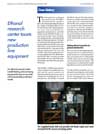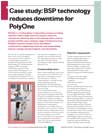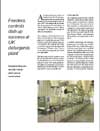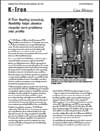|
General
|
|
|
|
|
|
|
|
|
|
Kason Products
|
|
|
|
|
|
|
|
|
|
|
|
|
|
|
|
|
|
|
|
K-Tron Products
|
|
|
|
|
|
|
|
|
|
|
|
|
|
Sturtevant Products
|
|
|
|
|
|
|
|
|
|
|
|
|
|
|
|
|
|
|
|
Western States
|
|
|
|
|
|
|
|
|
|
|
|
|
|
|
|
|
|
Abanaki Products
|
|
|
|
|
|
|
|
Articles are in English only unless otherwise noted. These PDF files require Adobe Acrobat Reader.
|
|
 Ethanol research center toasts new production line equipment installing feeding and conveying equipment to ensure accurate and reproducible production results Ethanol research center toasts new production line equipment installing feeding and conveying equipment to ensure accurate and reproducible production results
The National Corn-to-Ethanol Research Center (NCERC), Edwardsville, Ill., operates a full-scale ethanol pilot plant facility on the campus of Southern Illinois University Edwardsville. Ethanol producers, corn-seed-trait producers, equipment manufacturers, and other clients use the NCERC facility to research and test their ideas, products, and equipment that could potentially improve ethanol production. The facility’s clients use the data generated during the ethanol production process to make their own processes more efficient and productive. Because of this, when designing the facility, the NCERC specified feeding and conveying equipment for the ethanol production line that’s not only accurate and reliable, but can collect the material feedrates and other relevant operational data.
|
 Bulk Solids Pump (BSP) Technology Reduces Downtime for PolyOne Bulk Solids Pump (BSP) Technology Reduces Downtime for PolyOne
PolyOne is a leading global compounding company, providing customers with a single source for polymer, elastomer, colorant and additive products. The company offers a diverse product portfolio and a complete range of technical services. PolyOne's business includes color and additive masterbatches, engineering materials, vinyl compounding, polymer coatings and thermoplastic resin distribution. This article examines how the K-Tron Bulk Solids Pump integrated into the K4G Gravimetric Blender reduced downtime for PolyOne.
|
|
 Feeders, controls dish up success at UK detergents plant Feeders, controls dish up success at UK detergents plant
A leading European maker of laundry, household-cleaning, and personal-care products has operated a detergents plant in the UK since 1982. The main products are laundry detergent powders and tablets, as well as dishwashing powders, tablets, and liquids. The plant makes about 300 different formulations.
Over that time, the company had wrung every bit of capacity from the plant, first by running it 24 hours a day, 7 days a week, then by buying partly processed raw ingredients. But these steps weren’t enough to meet growing demand, and the company began planning a second detergents plant in October 1998. It also planned to streamline its packaging operations to handle more production and to resolve material flow issues around the site. Gravimetric feeders were an integral part of their success.
|
|
 K-Tron feeding accuracy, flexibility helps plastics recycler turn problems into profits K-Tron feeding accuracy, flexibility helps plastics recycler turn problems into profits
STAR Plastics of Millwood and Ravenswood, WV, specializes in second chances. To the plastics processor, off-spec formulations are an especially frustrating waste. The time and money invested in materials and processing resources become frozen in the plastic itself, unavailable to be converted into product or profit. Fortunately, the nature of many plastics allows for a second chance at achieving blend accuracy.
A crucial link in the reformulation process is the accuracy of the recycle and additive feeders. STAR Plastics’ newest online blending system, installed in early 2002 consists of a K-Tron K2-ML-T60 Twin Screw loss-in-weight feeder for the recycled plastic and a four-ingredient K2G-4 loss-in-weight additive blending station. Both units discharge to a screw conveyor leading to the pelletizing extruder. A majority of the company’s 17 extrusion lines employ some K-Tron feeders.
|

Feeders Save Time, Add Flexibility at Thermoplastic Facility
Omni Plastics, a thermoplastics compounder, saved 30 man hours during installation of a new production line featuring four loss-in-weight feeders. Wiring the feeders, which came equipped with smart controls, was quick and easy, saving the company $5,000 and valuable time. The new feeders also offered improved quality control and reliable operation.
|
|

 Ethanol research center toasts new production line equipment installing feeding and conveying equipment to ensure accurate and reproducible production results
Ethanol research center toasts new production line equipment installing feeding and conveying equipment to ensure accurate and reproducible production results Bulk Solids Pump (BSP) Technology Reduces Downtime for PolyOne
Bulk Solids Pump (BSP) Technology Reduces Downtime for PolyOne Feeders, controls dish up success at UK detergents plant
Feeders, controls dish up success at UK detergents plant
 K-Tron feeding accuracy, flexibility helps plastics recycler turn problems into profits
K-Tron feeding accuracy, flexibility helps plastics recycler turn problems into profits
